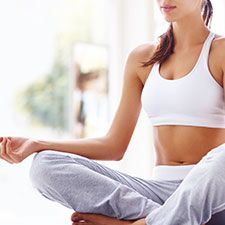“Sthira Sukham Asanam” — A Comfortable, Steady Seat----Yoga Sutras of Patanjali: Ch. 2.46–2.48
The popular yoga with which most of us are familiar is the yoga asana (literally “seat” in Sanskrit) practice that provides so much benefit on a physical and mental level. Flexibility, strength, physical tone, and the sometimes surprising depth of stress relief are often immediate and palpable. This is, of course, why it has become so much a part of our lives in this culture.
Beyond Physical Culture
When these largely physical practices are interwoven with even the most basic breathing and awareness practices, the benefits for the practitioner in overall well-being can skyrocket.
I agree with those who observe that when the deeper aspects of awareness and breath are not included, yoga practice naturally emphasizes its physical side. When those elements are woven in, the same poses become a way to uncover clarity and mindfulness in action on and off the yoga mat. Critically, this allows the brain and body to learn and adapt in an organic way that supports their natural processes of change and integration. In this way, movement becomes you.
Effort, Ease, and Awareness
This gift can be the possibility of self-discovery and more profound growth. We can discover on the yoga mat how releasing unnecessary struggle and self-judgment is the foundation of higher development. Learning to meet our limits with compassion rather than force can be the catalyst that leads to greater growth in our skills and comfort in yoga poses.
When the measure of our attainment of the yoga poses is no longer some external physical form seen in a magazine or demonstrated by the person next to us in class, a new process can begin. Your sense of being able to accept how your body can safely and comfortably be in each pose or movement begins to be your measure of success. There can become a balance of effort and ease that enhances the ability to be present amidst the changes and challenges that all yoga poses bring.
A Broader Understanding of Practice
In the ancient yogic text, the Yoga Sutra, the sage Patanjali called this attainment sukha sthira asanam (comfortable, steady pose). Though this concept specifically relates to cultivating the seated poses of meditation, I believe it can be a metaphor for how you can approach the physical practices of yoga to expand their scope and power to bring healthful growth. For the adventurous student, this new mode of exploration can be taken from the narrow confines of the yoga mat.
What We Feel, We Can Heal
In the physical practice of yoga asana, the steadiness and ease in any pose do not always occur without demand or challenge. We need to be challenged to build strength, burn calories, and recover lost flexibility. We need to address our mental limits to experience new ways of being.
The ideal of a comfortable, steady pose results from working through the blocks and resistances we all have. These struggles often reveal the present limitations or vulnerabilities that draw us to the healing possibilities of our practice in the first place.
To work through these experiences, yogis do not throw on music headphones or other distractions to ignore or blast through these parts of themselves to “get their yoga done.” Instead, I believe that intrinsic to the practice of yoga asana is the process of incorporating a growing faculty of open-hearted awareness within each pose. This allows the student the ability to gain the compassion and consciousness needed to translate asana instruction into an invitation to explore ever more deeply all that is revealed.
Under the maxim “what we feel we can heal,” the possibility grows that the outcome of our yoga practice will be the physical benefits, mental ease, balance, and growing peace that is the attainment of sukha sthira asanam.
The Yoga Sutras of Patanjali is a major yogic text given over 2,000 years ago by the yogic sage Patanjali. It codifies, in four chapters of aphorisms (threads or sutures), the essence of the eight limbs of Classical Raja Yoga. The third of these limbs is yoga asana, and the above quotation refers simply to the yogic embodiment of this practice.
Disclaimer
Results may vary. This information is for educational purposes only. Please remember that when practicing yoga, movement, and/or meditation techniques, you accept responsibility for all you do. It is not a treatment or substitute for medical care. Consult your doctor or mental health professional and work in accordance with your medical needs and limitations. I encourage you to seek out instruction and guidance from a qualified teacher to answer any questions and ensure the most positive experience.. Please read our disclaimerfor more information.

